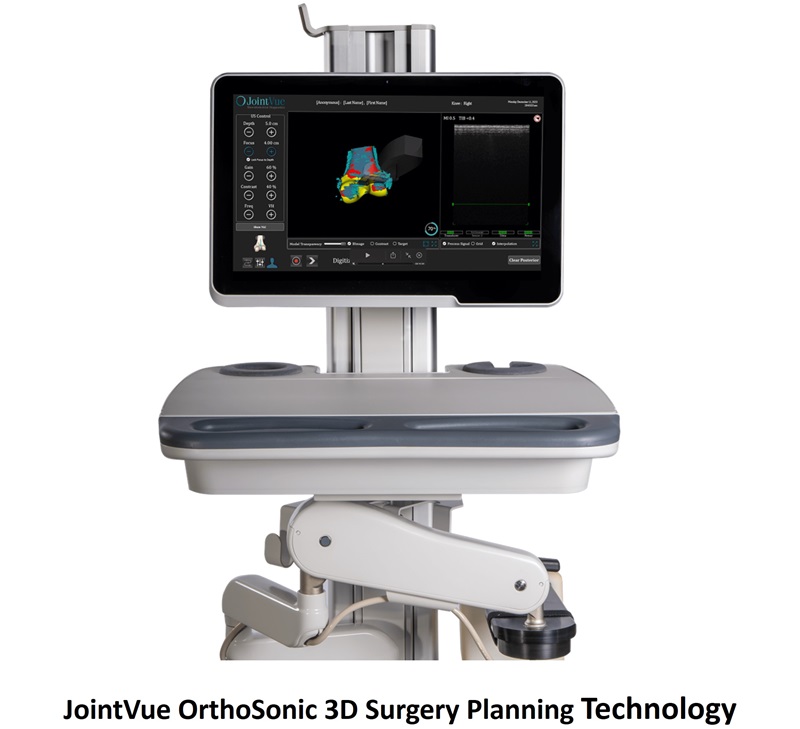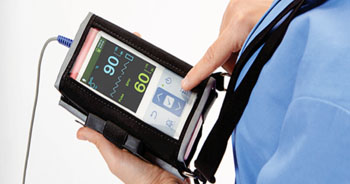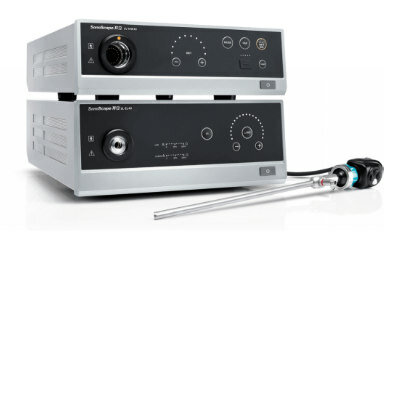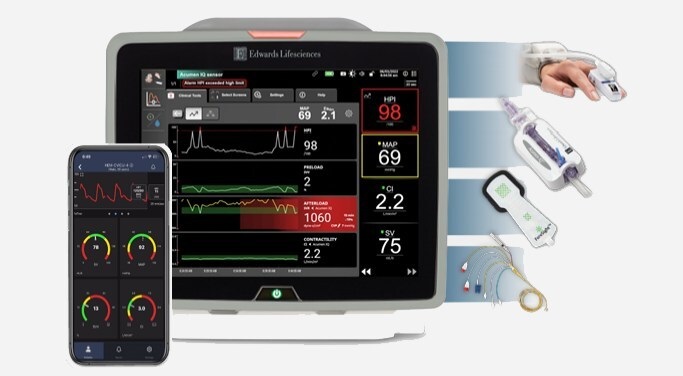Ergonomic Monitor Facilitates Pulse Oximetry Supervision
|
By HospiMedica International staff writers Posted on 02 Nov 2014 |
A portable handheld monitoring system offers a convenient platform for blood oxygen saturation (SpO2) spot-checks or continuous monitoring in hospital, mobile, and home use settings.
The user-friendly Nellcor PM10N portable SpO2 patient monitoring system features a simplified user interface that allows patients to clearly view their vital sign readings, while discouraging them from altering them on their own. This “home care” mode expands the utility of the monitor beyond the hospital environment. An added function is sleep study mode, which enables the clinician to dim the vivid 3-inch color liquid crystal display (LCD) screen and silence alarms to prevent disruption of patients’ sleep. The system includes connectivity to analytic tools and patient management systems.
Robust monitoring features include blood oxygen saturation, pulse rate, pleth waveform, blip bar, and tabular trend information. Advanced digital signal processing technology delivers accurate, reliable SpO2 and pulse rate values, even during low perfusion and signal interference, including during patient motion. A SatSeconds alarm management feature helps differentiate between serious and minor events, reducing clinically insignificant desaturation alarms and alarm fatigue. The monitor holds 80 hours of data storage capability.
Nellcor digital signal processing technology, which relies on cardiac-based signals, provides accurate readings that are closely tied to the patient’s physiology. The result is consistent performance during a number of challenging conditions, including patient motion, noise and low perfusion, all of which can impede the assessment of patient respiratory status. The Nellcor PM10N portable SpO2 patient monitoring system is a product of Covidien (Dublin, Ireland).
“Covidien is incorporating state-of-the-art technology to address critical patient issues, such as respiratory compromise and alarm management – all through a convenient, handheld design,” said Matt Anderson, vice president and general manager of patient monitoring at Covidien. “We continuously strive to develop new technology that both enhances and simplifies patient care. This new monitor is easy to use and brings our reliable pulse oximetry technology to patients both inside and out of the hospital.”
Related Links:
Covidien
The user-friendly Nellcor PM10N portable SpO2 patient monitoring system features a simplified user interface that allows patients to clearly view their vital sign readings, while discouraging them from altering them on their own. This “home care” mode expands the utility of the monitor beyond the hospital environment. An added function is sleep study mode, which enables the clinician to dim the vivid 3-inch color liquid crystal display (LCD) screen and silence alarms to prevent disruption of patients’ sleep. The system includes connectivity to analytic tools and patient management systems.
Robust monitoring features include blood oxygen saturation, pulse rate, pleth waveform, blip bar, and tabular trend information. Advanced digital signal processing technology delivers accurate, reliable SpO2 and pulse rate values, even during low perfusion and signal interference, including during patient motion. A SatSeconds alarm management feature helps differentiate between serious and minor events, reducing clinically insignificant desaturation alarms and alarm fatigue. The monitor holds 80 hours of data storage capability.
Nellcor digital signal processing technology, which relies on cardiac-based signals, provides accurate readings that are closely tied to the patient’s physiology. The result is consistent performance during a number of challenging conditions, including patient motion, noise and low perfusion, all of which can impede the assessment of patient respiratory status. The Nellcor PM10N portable SpO2 patient monitoring system is a product of Covidien (Dublin, Ireland).
“Covidien is incorporating state-of-the-art technology to address critical patient issues, such as respiratory compromise and alarm management – all through a convenient, handheld design,” said Matt Anderson, vice president and general manager of patient monitoring at Covidien. “We continuously strive to develop new technology that both enhances and simplifies patient care. This new monitor is easy to use and brings our reliable pulse oximetry technology to patients both inside and out of the hospital.”
Related Links:
Covidien
Read the full article by registering today, it's FREE! 

Register now for FREE to HospiMedica.com and get complete access to news and events that shape the world of Hospital Medicine. 
- Free digital version edition of HospiMedica International sent by email on regular basis
- Free print version of HospiMedica International magazine (available only outside USA and Canada).
- Free and unlimited access to back issues of HospiMedica International in digital format
- Free HospiMedica International Newsletter sent every week containing the latest news
- Free breaking news sent via email
- Free access to Events Calendar
- Free access to LinkXpress new product services
- REGISTRATION IS FREE AND EASY!
Sign in: Registered website members
Sign in: Registered magazine subscribers
Latest Critical Care News
- Cutting-Edge Bioelectronic Device Offers Drug-Free Approach to Managing Bacterial Infections
- Early TAVR Benefits Patients with Asymptomatic Severe Aortic Stenosis
- Sophisticated Machine-Learning Approach Uses Patient EHRs to Predict Pneumonia Outcomes
- First-Of-Its-Kind Experimental Therapy Enhances Tissue Repair After Heart Attack
- AI Model Predicts Patients at Most Risk of Complication During Treatment for Advanced Kidney Failure
- AI Model Predicts Patients’ Risk of Developing and Worsening Disease from ECGs
- Grain-Sized Soft Robots Controlled by Magnetic Fields Deliver Medical Drugs

- AI Tool Helps Identify Heart Failure Risk in Diabetes Patients
- Inflammation Reducing Antibody Could Serve as Cardio-Immunotherapy for Heart Failure Patients
- AI Tool Accurately Identifies Patients Who Could Require Emergency Hospital Admission
- Simple Risk Score Model Helps Wean Patients from Mechanical Circulatory Support
- AI-Powered Wearable Camera System Detects Errors in Medication Delivery

- Re-Engineered Immune Cells Penetrate and Kill Solid Tumors
- New Nanoparticle Nanotherapy Infusion Cleans Arteries
- Fluorescence Imaging a Game-Changer for Bedside Biofilm Detection
- Spongelike Bandage with Antimicrobial Efficacy Stops Hemorrhaging and Mitigates Risk of Infection

Channels
Surgical Techniques
view channel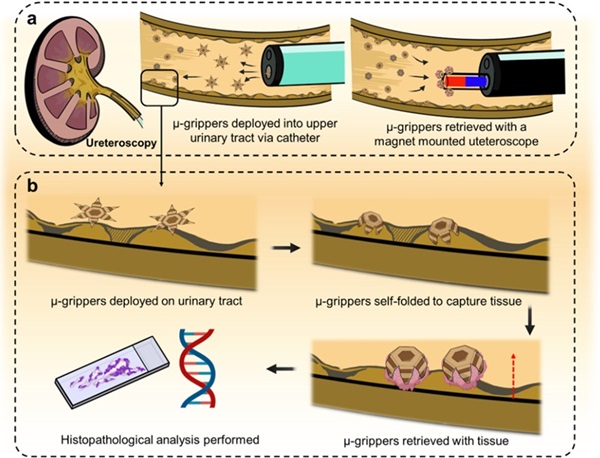
Microgrippers For Miniature Biopsies to Create New Cancer Diagnostic Screening Paradigm
The standard diagnosis of upper urinary tract cancers typically involves the removal of suspicious tissue using forceps, a procedure that is technically challenging and samples only a single region of the organ.... Read moreMiniature Soft Lithium-Ion Battery Could Be Used as Defibrillator During Surgery
The development of tiny smart devices, measuring just a few cubic millimeters, requires equally miniature power sources. For minimally invasive biomedical devices that interact with biological tissues,... Read more.jpg)
TAVI Procedure Supported by Radial Artery Access Reduces Bleeding Complications
The TAVI procedure, or Transcatheter Aortic Valve Implantation, is a minimally invasive technique in which a new aortic valve is inserted through a femoral artery to replace a narrowed old valve.... Read more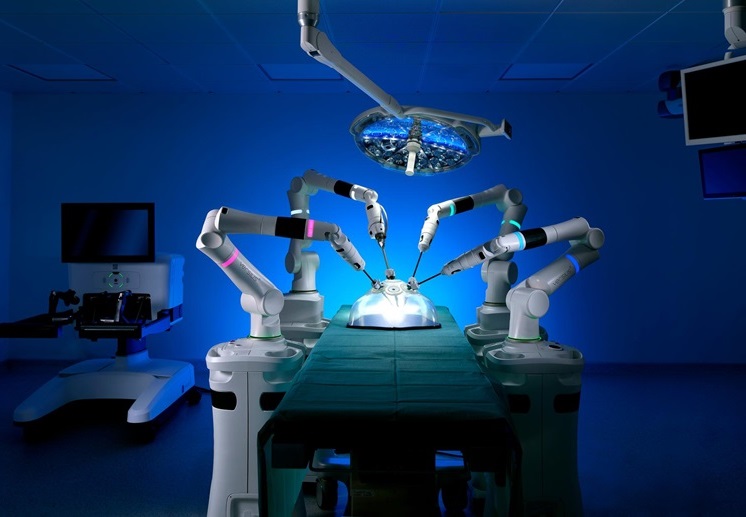
Portable Surgical Robot Seamlessly Integrates into Any OR for Performing Cholecystectomy Procedures
The United States represents a significant market with a strong demand for a flexible surgical robotic system applicable across various care settings. However, there has been a lack of sufficient options... Read morePatient Care
view channel
Portable Biosensor Platform to Reduce Hospital-Acquired Infections
Approximately 4 million patients in the European Union acquire healthcare-associated infections (HAIs) or nosocomial infections each year, with around 37,000 deaths directly resulting from these infections,... Read moreFirst-Of-Its-Kind Portable Germicidal Light Technology Disinfects High-Touch Clinical Surfaces in Seconds
Reducing healthcare-acquired infections (HAIs) remains a pressing issue within global healthcare systems. In the United States alone, 1.7 million patients contract HAIs annually, leading to approximately... Read more
Surgical Capacity Optimization Solution Helps Hospitals Boost OR Utilization
An innovative solution has the capability to transform surgical capacity utilization by targeting the root cause of surgical block time inefficiencies. Fujitsu Limited’s (Tokyo, Japan) Surgical Capacity... Read more
Game-Changing Innovation in Surgical Instrument Sterilization Significantly Improves OR Throughput
A groundbreaking innovation enables hospitals to significantly improve instrument processing time and throughput in operating rooms (ORs) and sterile processing departments. Turbett Surgical, Inc.... Read moreHealth IT
view channel
Machine Learning Model Improves Mortality Risk Prediction for Cardiac Surgery Patients
Machine learning algorithms have been deployed to create predictive models in various medical fields, with some demonstrating improved outcomes compared to their standard-of-care counterparts.... Read more
Strategic Collaboration to Develop and Integrate Generative AI into Healthcare
Top industry experts have underscored the immediate requirement for healthcare systems and hospitals to respond to severe cost and margin pressures. Close to half of U.S. hospitals ended 2022 in the red... Read more
AI-Enabled Operating Rooms Solution Helps Hospitals Maximize Utilization and Unlock Capacity
For healthcare organizations, optimizing operating room (OR) utilization during prime time hours is a complex challenge. Surgeons and clinics face difficulties in finding available slots for booking cases,... Read more
AI Predicts Pancreatic Cancer Three Years before Diagnosis from Patients’ Medical Records
Screening for common cancers like breast, cervix, and prostate cancer relies on relatively simple and highly effective techniques, such as mammograms, Pap smears, and blood tests. These methods have revolutionized... Read morePoint of Care
view channel
Handheld, Sound-Based Diagnostic System Delivers Bedside Blood Test Results in An Hour
Patients who go to a doctor for a blood test often have to contend with a needle and syringe, followed by a long wait—sometimes hours or even days—for lab results. Scientists have been working hard to... Read more
Smartphone-Enabled, Paper-Based Quantitative Diagnostic Platform Transforms POC Testing
Point-of-care diagnostics are crucial for public health, offering rapid, on-site testing that enables prompt diagnosis and treatment. This is especially valuable in remote or underserved regions where... Read moreBusiness
view channel
Hologic Acquires Gynesonics to Strengthen Existing Gynecological Surgical Business
Hologic (Marlborough, MA, USA) has signed a definitive agreement to acquire Gynesonics (Redwood City, CA, USA) for approximately USD 350 million, subject to working capital and other customary closing adjustments.... Read more